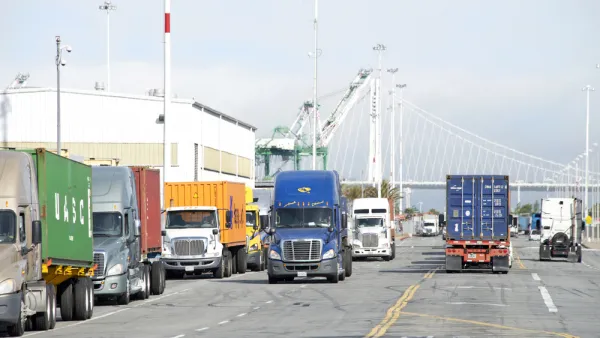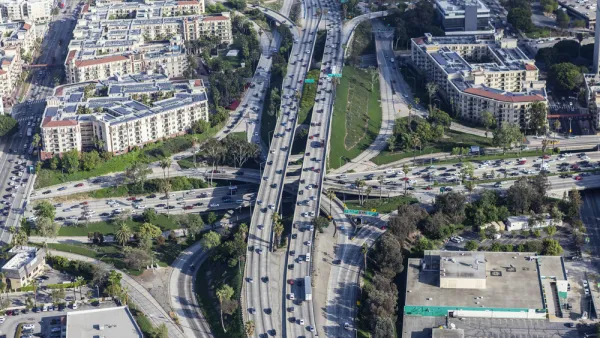The Los Angeles Times follows-up an earlier article on the dangers of building too close to freeways. It's a trade-off that the California Air Resources Board acknowledged last April with new guidelines that recognize the dire need for housing.
The post is based on a report by Tony Barboza and David Zahniser of the Los Angeles Times who wrote a follow-up on Dec. 27 that explains why the Air Resources Board (ARB) is willing to accept projects selected by the Strategic Growth Council even when the siting goes against their own recommendations.
And it's not just subsidized affordable housing developments being built too close to freeways.
Los Angeles "issued building permits for 4,300 homes near freeways in 2015 — more than in any year over the last decade — and signed off on an additional 3,000 units last year," reported Barboza and Jon Schleuss for the Times on March 2, 2017.
Last April, the board "issued a new advisory [pdf] that emphasizes design rather than distance, recommending anti-pollution features such as air filters, sound walls and thick vegetation as 'promising strategies' to reduce the health risks from freeways," write Barboza and Zahniser. Recommendations also include architectural and transportation mitigations, including street design and pedestrian and bicycle infrastructure:
Among the suggestions in the report: Lower speed limits to 55 mph or less and install roundabouts to reduce vehicle emissions. Design city streets with parks, bike lanes, wider sidewalks and buildings with “varying shapes and heights” to disperse traffic pollutants.
Those projects are challenging in cities like Los Angeles, “where freeways and major thoroughfares abound,” air board spokesman Stanley Young said. “In responding to that reality we felt it was important to give planners and developers information on how to mitigate the impacts,” he added.
However, ARB hasn't abandoned their 2005 handbook either. "That’s a very basic health position that the agency has taken and we still stand by,” said Kurt Karperos, a deputy executive officer for the air board,
Yet it's clear that ARB has become more flexible, evidenced in January 2016 when "air board chair Mary Nichols acknowledged that the push for dense urban development, which can reduce driving and overall emissions, also can 'result in increased exposures for people who live or go to school and spend any time outdoors in areas near roadways,'” add Barboza and Zahniser.
Housing activists and business leaders have cheered the new design advisory while public health and environmentalists bemoan them.
Alan Greenlee, executive director of the Southern California Assn. of Non-Profit Housing, said he is happy the state “seems to have moved in the direction of allowing building where previously they weren’t interested.” With filters and other anti-pollution measures, developers “can house people affordably and healthfully in areas where the government says there are air quality issues.”
Bill Magavern, policy director for the Coalition for Clean Air, has a far different perspective.
"New housing should be well planned so that it’s not putting residents’ health at risk,” he said. “The goal is to have the homes near transit, not near freeways.”
However, in a third piece, Barboza reports on Dec. 30 that exposure to harmful motor vehicle emissions is not just a matter of proximity to heavily traveled roads.
In the late night and early morning, it turns out, traffic pollution drifts much farther than during the day, and can extend more than a mile downwind from the freeway.
It’s not only your distance from traffic, but other details such as wind patterns, freeway design, the time of day and the types of cars, trucks and buildings around you that determine the risk.
This piece has lots of interesting information on how to mitigate exposure to traffic air pollution and what factors to look for that influence exposure.
FULL STORY: Regulators warned against housing near freeways due to health risks. Now they're warming to it

Analysis: Cybertruck Fatality Rate Far Exceeds That of Ford Pinto
The Tesla Cybertruck was recalled seven times last year.

National Parks Layoffs Will Cause Communities to Lose Billions
Thousands of essential park workers were laid off this week, just before the busy spring break season.

Retro-silient?: America’s First “Eco-burb,” The Woodlands Turns 50
A master-planned community north of Houston offers lessons on green infrastructure and resilient design, but falls short of its founder’s lofty affordability and walkability goals.

Test News Post 1
This is a summary

Analysis: Cybertruck Fatality Rate Far Exceeds That of Ford Pinto
The Tesla Cybertruck was recalled seven times last year.

Test News Headline 46
Test for the image on the front page.
Urban Design for Planners 1: Software Tools
This six-course series explores essential urban design concepts using open source software and equips planners with the tools they need to participate fully in the urban design process.
Planning for Universal Design
Learn the tools for implementing Universal Design in planning regulations.
EMC Planning Group, Inc.
Planetizen
Planetizen
Mpact (formerly Rail~Volution)
Great Falls Development Authority, Inc.
HUDs Office of Policy Development and Research
NYU Wagner Graduate School of Public Service



























